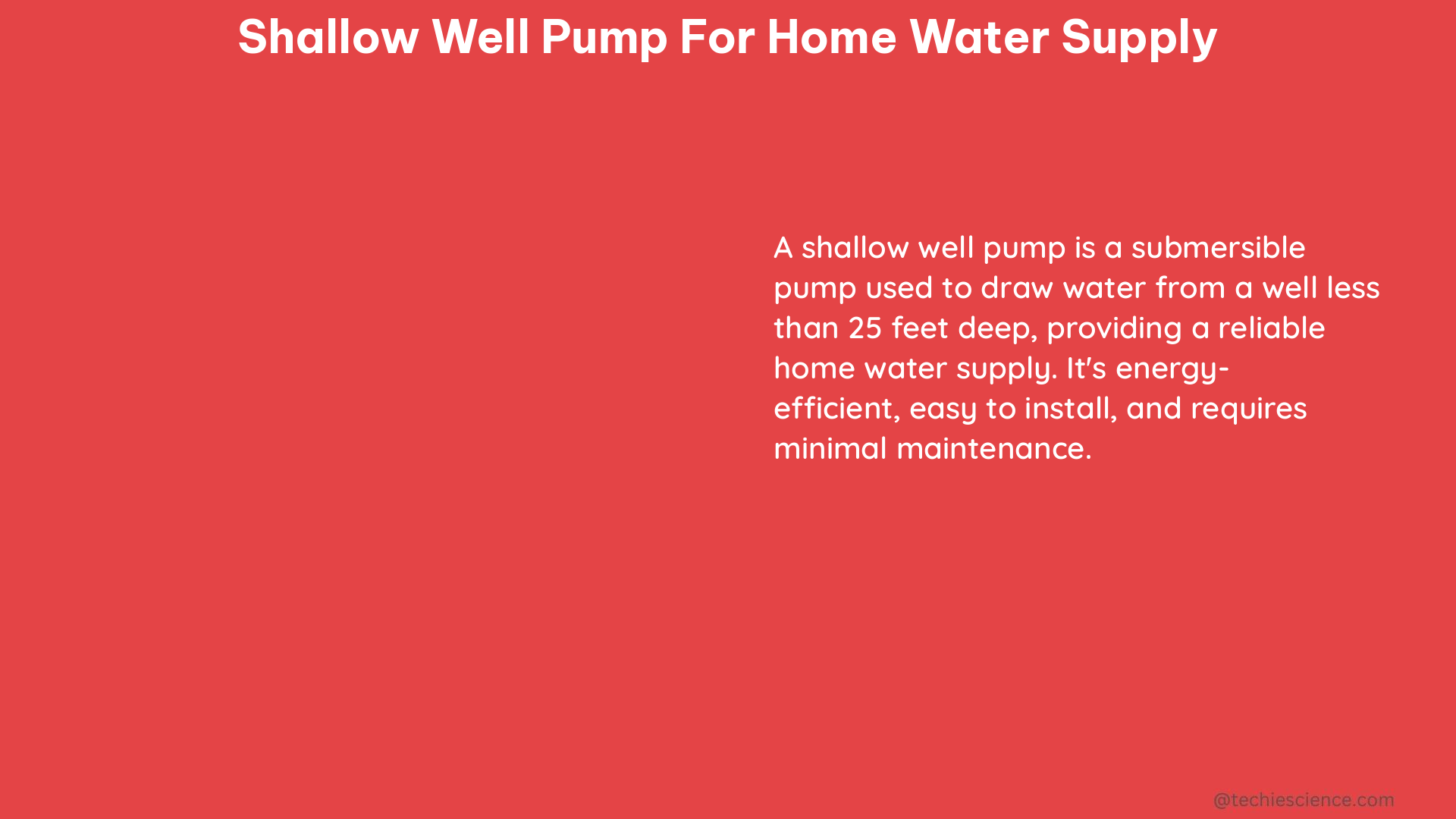Shallow well pumps are essential for providing a reliable water supply to homes that rely on wells with a water table of less than 25 feet. These pumps are designed to lift water from shallow wells and deliver it to the home’s plumbing system. When selecting a shallow well pump for home water supply, there are several critical factors to consider, including the pump’s horsepower, flow rate, and total dynamic head (TDH).
Horsepower (HP) Considerations
Horsepower (HP) is a measure of the pump’s power and indicates how much water it can move. Shallow well pumps typically have horsepower ratings ranging from 1/2 HP to 3 HP. The appropriate horsepower for a particular application depends on several factors:
- Well Depth: Deeper wells require more horsepower to lift the water. For example, a 1/2 HP pump may be sufficient for a well with a water table of 15 feet, while a 3 HP pump may be necessary for a well with a water table of 25 feet.
- Well Casing Diameter: Larger well casing diameters (e.g., 6 inches) require more horsepower to overcome the increased friction loss compared to smaller diameters (e.g., 4 inches).
- Water Demand: Households with higher water usage, such as those with multiple bathrooms and appliances, will require a higher horsepower pump to meet the peak demand.
As a general guideline, a 1/2 HP pump can typically handle a well depth of up to 25 feet and a water demand of up to 7 GPM, while a 3 HP pump can handle a well depth of up to 100 feet and a water demand of up to 30 GPM.
Flow Rate Considerations

Flow rate is another critical specification for shallow well pumps. It is measured in gallons per minute (GPM) and indicates how much water the pump can deliver in a minute. The required flow rate depends on the household’s water demand, which is determined by the number of fixtures and appliances that use water. For example:
- A typical household with two bathrooms and a dishwasher requires a flow rate of at least 7 GPM to meet peak demand during morning and evening hours.
- A larger household with four bathrooms, a washing machine, and multiple showers may require a flow rate of 15 GPM or more.
It’s important to select a pump with a flow rate that can meet the peak water demand of your household to ensure adequate water pressure and flow throughout the plumbing system.
Total Dynamic Head (TDH) Considerations
Total dynamic head (TDH) is a measure of the pressure required to lift water from the well to the home’s plumbing system. It includes the following components:
- Vertical Lift (Suction Head): The distance from the water level in the well to the pump’s inlet.
- Pressure Head: The friction loss in the pipes and fittings as the water is pumped through the system.
- Static Head: The pressure required to deliver water to the highest fixture in the home.
The TDH for a particular application depends on several factors:
- Well Depth: Deeper wells require more vertical lift and, therefore, a higher TDH.
- Pipe Length and Diameter: Longer pipes and smaller diameters increase the pressure head component of the TDH.
- Plumbing System Height: The higher the plumbing system, the greater the static head component of the TDH.
As a general guideline, a shallow well pump with a TDH of 50-70 feet is suitable for most residential applications with a well depth of less than 25 feet and a typical plumbing system height.
Other Considerations
In addition to the technical specifications, there are several other factors to consider when selecting a shallow well pump for home water supply:
- Noise Level: Some pumps are designed to be quieter than others, which can be essential if the pump is located near living areas.
- Ease of Maintenance: Pumps that are easy to service can save time and money in the long run.
- Durability: A pump that lasts longer will save money in the long run and provide a more reliable water supply.
- Energy Efficiency: More energy-efficient pumps can reduce operating costs over time.
- Compatibility: Ensure the pump is compatible with your well casing diameter and plumbing system.
By carefully considering these factors, you can select a shallow well pump that meets your home’s water demand and provides a reliable, long-lasting water supply.
Conclusion
When selecting a shallow well pump for home water supply, it is essential to carefully evaluate the pump’s horsepower, flow rate, and total dynamic head (TDH) to ensure it meets your household’s water demand. Additionally, other factors such as noise level, ease of maintenance, durability, and energy efficiency should be considered to ensure a reliable and cost-effective water supply for years to come.
References
- Grundfos Ecademy: How to select the right pump for boosting water from a water storage tank – https://www.grundfos.com/us/learn/ecademy/all-courses/the-domestic-water-pressure-boosting-course/how-to-select-the-right-pump-for-boosting-water-from-a-water-sto
- DoItYourself.com: Choosing new shallow-well pump – 1/2 vs. 3/4hp? Gould? jet? noise? – https://www.doityourself.com/forum/wells-sump-pumps-septic-sewage-systems/339126-choosing-new-shallow-well-pump-1-2-vs-3-4hp-gould-jet-noise.html
- Water Systems Council: Sizing a Well Pump – https://www.watersystemscouncil.org/download/wellcare_information_sheets/basic_well_information_sheets/Sizing-a-Well-Pump.pdf

The lambdageeks.com Core SME Team is a group of experienced subject matter experts from diverse scientific and technical fields including Physics, Chemistry, Technology,Electronics & Electrical Engineering, Automotive, Mechanical Engineering. Our team collaborates to create high-quality, well-researched articles on a wide range of science and technology topics for the lambdageeks.com website.
All Our Senior SME are having more than 7 Years of experience in the respective fields . They are either Working Industry Professionals or assocaited With different Universities. Refer Our Authors Page to get to know About our Core SMEs.